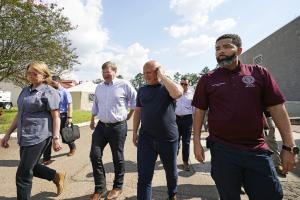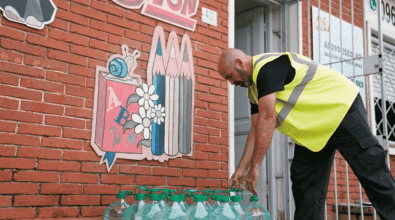 Read More
Read More
Winning local strategies for capitalizing on federal dollars

Jackson, Miss., Mayor Chokwe Antar Lumumba (far right) tours a water treatment facility with former White House Infrastructure Coordinator Mitch Landrieu (second from right). (AP Photo/Rogelio V. Solis, Pool)
Listen to This Article
Two years after passage of the Bipartisan Infrastructure Law, we know what makes for a winning grant application. This is especially true for the more than 1,200 municipalities and 3,200 local officials who have worked with the Local Infrastructure Hub—a national program led by Bloomberg Philanthropies, Ballmer Group, Emerson Collective, Ford Foundation, The Kresge Foundation, The U.S. Conference of Mayors, National League of Cities, Results for America, and more—to strengthen their efforts.
At the same time, 80 percent of competitive funding provided under that law was still available as recently as late last year, according to an analysis by the Brookings Institution. Combine that with the massive amount of money available under other recent federal laws that local leaders can apply for directly, and it’s clearly not too late for cities to get started.
Many of the granular steps any city might take to search, assess, and apply for infrastructure grants in particular are captured in presentations and toolkits provided by the Local Infrastructure Hub. But to help municipalities think about their big-picture approach to federal funds more broadly, we’re pulling back the curtain on cases where city leaders either have already won resources or put themselves in position to assemble competitive applications.
Built internal capacity and secured external partners.
Not every city has a staff in place to tackle grant work. In fact, in capacity-constrained communities, city employees are often juggling applications with other urgent responsibilities. But cities are finding ways to overcome these roadblocks.
In Jackson, Miss., identifying a local partner to help with the legwork was a breakthrough. There, the Department of Public Works received Safe Streets for All funding without agency staff having to do it alone. In fact, the application was submitted by the Central Mississippi Planning and Development District, not the city itself.
Likewise, cities are benefiting from teaming up with local cultural institutions that are hungry to bring in investment and have the capacity to take the lead on applications. And in some cases, regional commissions and associations also receive direct appropriations that cities are tapping to meet federal grant match requirements.
Finally, cities have had success asking lawmakers to give them more grant-seeking horsepower. Even as local officials were finding inroads with partnerships, Jackson got approval for three staff positions for grant work. They’ve already made two hires for that team who could help change the game in terms of their capacity to go after additional funds.
Mapped residents' needs to craft compelling application narratives.
Storytelling may not be something cities traditionally devote an enormous share of their resources to, at least outside of public engagement and communications departments. But narratives in grant applications are helping cities show they’ve connected the dots between financial opportunities and resident needs.
“The federal government wants to know that you have gone out into the community and heard from constituents about their needs and priorities,” says Michelle Thomas, a former business administrator for the city of Newark, who now advises local governments. “For example, institutions of higher education, particularly historically Black colleges and universities, can contribute a range of expertise, bolstering a project’s effectiveness.”
Kokomo, Ind., a city of just 60,000 people, was awarded a $200,000 planning grant in partnership with its county government to develop a comprehensive safety plan to reduce road injuries and fatalities. The city did that in part by promising to address equity, with a plan to compare underserved census tracts with other areas of the city and focus on non-English speakers and people who don’t drive cars.
Producing compelling ideas for local change is one thing. But showing that they’ve put in the work to solicit feedback, dig into the data, and develop a way to reach marginalized community members has helped cities take things to another level.
Sought grants that benefited neighbors, too.
If outside institutions like planning associations have lightened cities’ workload in applying for grants, neighboring cities that will share in the results of a project—and can be part of the case for its actual value—have helped supercharge this work.
Take the small city of Athens, Ohio. Officials won a massive $12.5 million grant for electric-vehicle charging infrastructure by making a compelling case that the city and its neighbors—like Dayton—were worth a major outlay of resources. This project is located entirely within what the U.S. Department of Transportation defines as disadvantaged communities. Athens County, of which Athens is the county seat, has one of the highest poverty rates in Ohio.
As the mayor of Athens, Steve Patterson, wrote in the Columbus Dispatch before the grant was awarded, “The federal government…wanted a bigger impact than just a handful of stations in a small community.” So the city worked with the region to demonstrate how 58 EV charging stations would help 19 disadvantaged communities join the electric-vehicle revolution—and, leveraging a partnership with a regional electricity aggregator, won big.
Work like that in Athens, which Mayor Patterson credits to his participation in the Local Infrastructure Hub’s months-long grant-writing bootcamps, may represent the most exciting potential of all. In addition to finding ways to help residents, cities and small towns alike are using this grant-seeking process to build solidarity with their neighbors—and expanding their definition of community.
Megan Sheekey leads Strategic Partnerships for Bloomberg Associates (BA), a philanthropic consultancy that advises cities around the world. Rose Gill is a Principal at BA who helped establish the e311 program.

